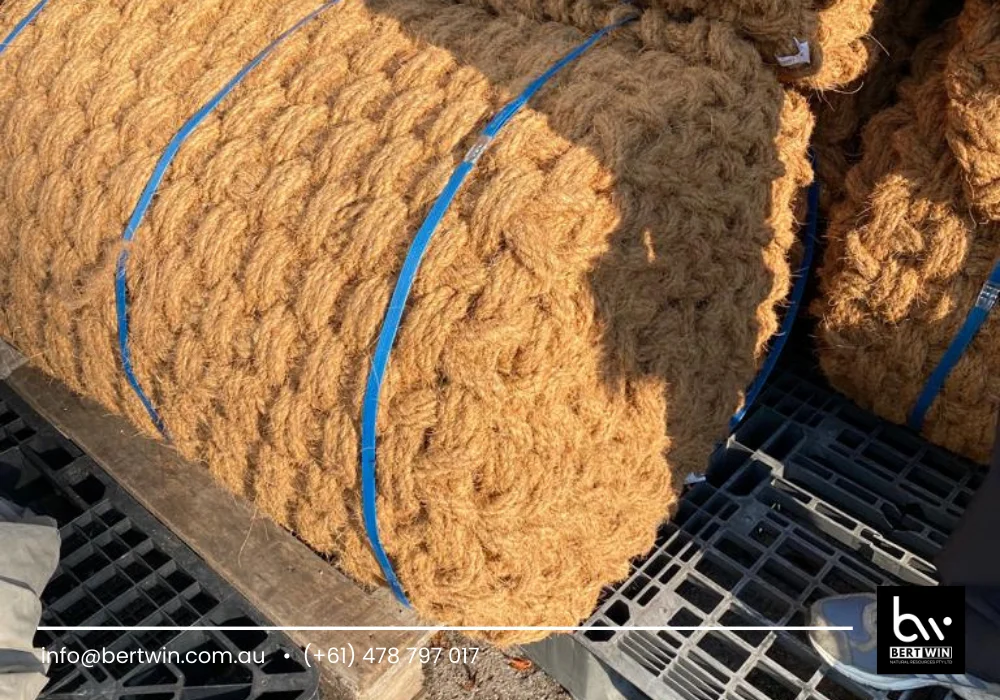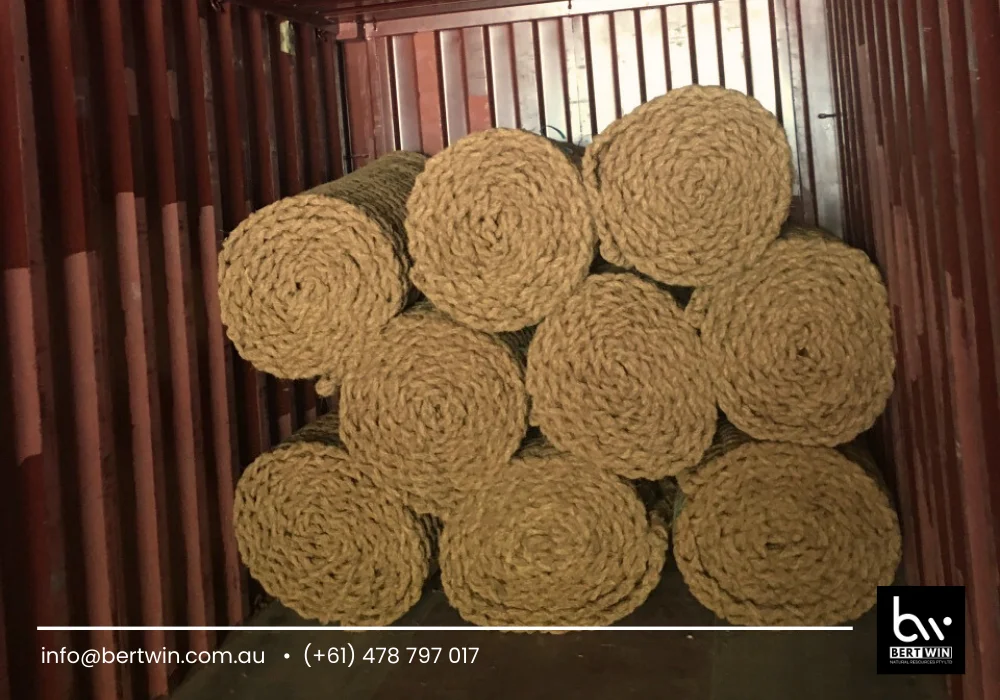
Coir matting erosion control, made from strong coconut fibers, is a game-changer for protecting landscapes. This natural solution effectively combats soil erosion while promoting vegetation growth on the ground surface. Made from coconut husks, coir mats are eco-friendly and durable biodegradable erosion control products. They provide stability to slopes and riverbanks, making them ideal for various environments. These mats offer excellent erosion control protection, are environmentally friendly, and enhance soil moisture retention, supporting plant health. By using biodegradable mats like coir matting, you not only safeguard your land but also contribute to a greener planet. Discover how these biodegradable mats made of bristle coir fiber and natural coconut fibers can transform your erosion control efforts today.
Benefits of Coir Matting
Soil Stability and Protection
Coir matting helps stabilize soil in various environments. It reduces erosion by holding the soil in place. The natural fibers create a strong barrier against water flow. This barrier prevents soil loss during heavy rains.
The matting also promotes healthy root growth. Plants can establish themselves more quickly with coir matting. Strong roots further enhance soil stability.
Environmental Advantages
Using coir matting has several environmental benefits. It is made from coconut husks, a renewable resource. This means it is biodegradable and eco-friendly. Coir matting supports biodiversity by providing habitat for small organisms.
It also improves water retention in the soil. This helps reduce the need for irrigation. Healthy ecosystems thrive with better moisture levels.
Cost-Effectiveness
Coir matting offers significant cost savings over time. Initial costs are often low compared to synthetic alternatives. Its effectiveness in preventing erosion reduces the need for frequent repairs.
Long-term, coir matting minimizes maintenance costs. Fewer resources are needed for landscaping and soil management.
Longevity and Durability
Coir matting is known for its durability. It can withstand harsh weather conditions without breaking down quickly. The fibers are strong and resistant to decay.
With proper installation, coir matting lasts several years. This longevity makes it a practical choice for erosion control projects.

Types of Coir Matting
Woven Coir Mats
Woven coir mats are made from interlaced coconut fibers. These fibers provide a strong and durable surface. They resist wear and tear, making them ideal for high-traffic areas. Woven mats absorb water well, which helps prevent soil erosion. Their design allows for good air circulation, promoting plant growth underneath.
Non-Woven Coir Blankets
Non-woven coir blankets consist of compressed coconut fibers. These blankets offer excellent coverage for large areas. They help stabilize soil and reduce runoff during heavy rains using sturdy coconut fiber erosion control mat. Non-woven materials also promote seed germination by retaining moisture. The thickness of these blankets varies, allowing flexibility based on the project needs.
Coir Logs and Wattles
Coir logs and wattles serve as barriers against erosion. Coir logs are cylindrical structures filled with coconut fiber. They are placed along slopes or riverbanks to slow down water flow using coir erosion control mats. Wattles are similar but thinner and often used in smaller applications. Both options, a sturdy coconut fiber erosion control mat and coir mat, trap sediment and help establish vegetation over time.
Applications in Coir Matting Erosion Control
Slope Stabilization
Coir matting erosion control is a versatile solution used in various environmental applications. One of its key roles is in slope stabilization. It provides a natural barrier against soil erosion on steep slopes using coir matting, which is effective in areas prone to landslides or heavy rains. The fibrous structure of coir absorbs water and reduces runoff, maintaining soil integrity. In fact, coir matting erosion control has been used in several regions, including India, for stabilizing hillsides since the early 2000s.
Riverbank Protection
Riverbank protection using coir matting erosion control has gained popularity. It protects banks from the erosive forces of flowing water using a sturdy coconut fiber erosion control mat. Coir matting erosion control helps to establish vegetation quickly, creating roots that hold soil in place. This technique has been applied along rivers in the United States, particularly after flooding events. The mats provide an eco-friendly solution compared to concrete barriers.
Roadside Erosion Prevention
Coir matting erosion control is also effective for roadside erosion prevention. Roads often face erosion due to rainfall and traffic. Installing coir matting along embankments can significantly reduce soil loss. These mats allow grass and plants to grow, which further stabilizes the area. Many local governments have adopted this approach since the late 1990s to protect infrastructure.

Choosing the Right Coir Matting
Assess Project Needs
Identify the specific requirements of your project. Consider the size of the area needing protection. Different projects may require different types of coir matting. For instance, a steep slope might need thicker matting for better stability.
Understanding the level of erosion risk is crucial. Areas with heavy rainfall may require more durable options. Take note of local regulations regarding erosion control as well, including coir mat.
Evaluate Environmental Conditions
Analyze the local climate and soil type. Coir matting works best in environments with consistent moisture. Sandy or loose soils often benefit from coir’s fibrous structure with a sturdy coconut fiber erosion control mat.
Check for existing vegetation as well. Healthy plants can help support coir matting and enhance its effectiveness. In contrast, areas with poor soil may need additional amendments before installation.
Desired Outcomes and Goals
Define what you hope to achieve with coir matting. Are you looking to reduce soil loss or improve plant growth with a sturdy coconut fiber erosion control mat or coir mat? Setting clear goals helps in selecting the right product.
Consider long-term benefits like habitat restoration or water quality improvement. Each goal may require different specifications for coir matting. For example, if wildlife support is a priority, select options that promote vegetation growth.
Final Remarks
Coir matting erosion control is a game-changer. It offers durability, eco-friendliness, and effective stabilization for your landscapes. You’ve seen the benefits, types, and applications that make it an ideal choice. Selecting the right coir matting can significantly impact your erosion control efforts.
Now’s the time to put this knowledge into action. Explore the options available to you and invest in coir matting for a sustainable solution to erosion issues. Your landscape will thank you for it. Don’t wait—take the first step toward a greener future today!

Frequently Asked Questions
What is coir matting?
Coir matting is a natural fiber product made from coconut husk. It is used for various applications, particularly in erosion control, due to its durability and biodegradability.
How does coir matting help with erosion control?
Coir matting stabilizes soil by reducing surface runoff and protecting against wind and water erosion. Its fibrous texture helps retain moisture while promoting vegetation growth.
What are the benefits of using coir matting?
Coir matting offers several benefits, including environmental sustainability, cost-effectiveness, and ease of installation. It also enhances soil health and supports plant growth.
Are there different types of coir matting?
Yes, there are various types of coir matting, such as coir geotextiles, coir rolls, and coir blankets. Each type serves specific purposes based on project requirements.
Where can I use coir matting for erosion control?
Coir matting is ideal for slopes, riverbanks, construction sites, and areas prone to soil erosion. It effectively protects vulnerable landscapes from degradation.
How do I choose the right coir matting?
Consider factors like the specific application, site conditions, and desired longevity. Consulting with experts can help you select the most suitable type for your needs.
Is coir matting environmentally friendly?
Yes, coir matting is biodegradable and made from renewable resources. Its use promotes eco-friendly practices in landscaping and construction projects.
In conclusion, if you are eager to delve deeper into the details of coir products, feel free to explore our website at www.bertwin.com.au. Additionally, for direct and instant connection with our team, you can reach us through the following WhatsApp link here. We look forward to providing you with the information and assistance you need.
